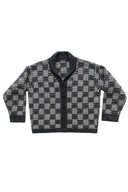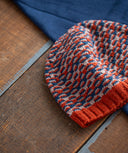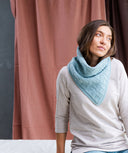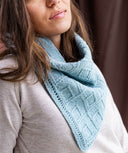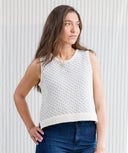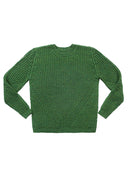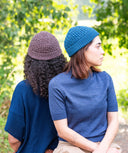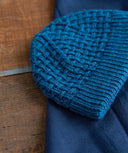Woolen and Worsted Yarn
There are myriad ways to prepare and spin fleece and fiber into yarn. This exciting variety can be attributed to similarly multiple factors such as individual spinning style and preference, fleece and fiber characteristics, or even environmental considerations like humidity levels. At Brooklyn Tweed, we employ two basic spinning methods that occupy either end of this broad spectrum of possibility: woolen-spinning and worsted-spinning.
These two spinning techniques are also the basic, standardized methods employed in commercial yarn production — though, as noted in Knitting in the Old Way by Priscilla A. Gibson-Roberts and Deborah Robson, more and more spinning mills today follow a hand spinning approach to commercial spinning, adapting processing and spinning techniques to enhance the natural characteristics of a particular fiber or to achieve a yarn well-suited for specific kinds of knitted fabric.
In this installment of our Foundations series, we explain the differences between how our woolen-spun and worsted-spun yarn families are produced, as well as describe the different kinds of fabrics one can achieve with either kind of yarn.
Note: We will specifically explain the commercial woolen- and worsted-spinning methods employed by the mills we work with. However, because commercial spinning techniques necessarily developed out of hand spinning techniques, the terms described here may also be familiar to our hand spinning friends or applicable to those interested in handspinning.
Woolen-Spun
Before beginning the process of spinning our woolen-spun yarns, the fiber is first cleaned and then dyed in the fleece. Scouring, the process in which fleece is cleaned, removes dirt and excess lanolin from the raw wool. To produce our heathered colors, the scoured fleece is then dyed in a range of intensely saturated base solids, which are then blended together during the spinning process using percentages of the base colors unique to each colorway.

To begin the spinning process, a picker is used to loosely separate large masses of fiber into smaller ones and to mix the heathered shades of our woolen-spun yarns.

After picking, the fiber goes through a carder, a machine with several rolling cylinders covered in metal teeth. The carder opens up the fiber and blends it evenly, resulting in a thin cloud- or web-like sheet commonly known as a batt. The doffer, a large cylinder at the delivery end of the carder, then relays the batt into a condenser, which splits the batt into several thin, untwisted strands called roping or slivers (sly-vers). The terms “roping” and “sliver” are often used interchangeably. However, “roping” is more commonly used to refer specifically to this stage in woolen-spinning mills.

The next step after preparing the fiber is to add twist, as this is key to making yarn — twist traps necessary energy and tension into the yarn, increasing strength and, in most cases, elasticity. The amount of twist added when making individual plies of yarn is very important and can take the hand and behavior of the yarn in different directions. Any amount of twist, be it a lot or a little, is essential for creating knittable yarn.
At the roping stage, the fibers are of irregular lengths, jumbled and nestled together in every which way. These carded strands are lofty, lightweight, and trap a lot of air. According to Clara Parkes’s The Knitter’s Book of Yarn, spinning or adding twist to the fiber while it is in a jumbled state (in other words, in a woolen-preparation) is one key aspect of woolen-spun yarns. Another essential characteristic of woolen-spun yarns, according to Respect the Spindle by Abby Franquemont, is that twist is allowed to play an active role in drafting the fiber — drafting refers to when the fiber is pulled slightly to open up and lengthen the fiber structure before being twisted.
As such, for our woolen-spun yarns, the strands of roping are simply loaded on a spinning frame, where they are concurrently drafted, twisted, and wound onto bobbins to become singles for plying. After steaming, which allows the fibers to relax into their newly twisted state, the singles of twisted yarn are then loaded on a twisting frame to be plied together — both Shelter and Loft are comprised of two singles gently twisted together to create a two-ply yarn.>
In the production of Quarry, which was inspired by unspun yarns, we skip the process of spinning the individual “plies” of yarn and instead nestle together three strands of roping drawn out to the right thickness, before gently twisting those strands together in a mock twist.

Note: Notice how the individual plies of Loft, Quarry, and Shelter (shown above, top to bottom) appear wispy and how the fibers in each single are oriented in every direction and nestled together in a disorderly manner. (There’s a method to this madness, we promise!)
The result of this woolen-style preparation and spinning is a yarn that retains the lofty, air-trapping qualities it had before spinning. This means it offers remarkable warmth and lightness and is adaptable in gauge, able to compress to a denser fabric on small needles or bloom to cohere as a gauzy fabric when worked on large needles.
See the woolen-spun process in action:
Worsted-Spun
As with our woolen-spun yarns, fiber prepared for worsted-spun yarn is first scoured and then carded. This carded wool from the initial fiber preparation is prepared further in a worsted-style through combing. Combing the jumbled fibers aligns them in a parallel fashion and also removes shorter fibers for uniform length. The combed wool is then sent through a pin drafter several times, resulting in the wool sliver becoming progressively thinner with each pass through the machine. The rub roller next turns the sliver into roving and adds a false twist.

Worsted-style spinning, unlike woolen-style, does not allow twist to enter the fiber during drafting. As such, for our worsted-spun yarns, once the roving is loaded on the spinning frame, they first pass through a draft zone, which drafts the fiber to open it up and reduce it to the intended weight (and thickness) required for the yarn. Twist is then inserted only as the fibers exit the draft zone, not concurrently as in our woolen-spun yarns. The twisted singles are then plied together on the twisting frame — Arbor is comprised of three plies, while Vale is comprised of two.

Note: Notice how the individual plies of Arbor and Vale (shown above, top to bottom) appear more compacted and how the fibers in each single are oriented in the same direction.
The result of this worsted-style preparation and spinning is a yarn that is smooth and dense, due to the fibers being neatly combed in a parallel fashion. The smoothness of the yarn means that the stitches knit from them sing proudly and have excellent definition, while the compactness of the yarn contributes to fabrics with greater drape.

After being spun into yarn, our worsted-spun yarns are dyed in the skein. Dye baths are created using a precise calibration of dye, temperature, and water flow to protect the lofty, softness of the wool and to ensure the colors are repeatable with every new dye lot.
See the worsted-spun process in action:
Which style do you choose?

To aid you in making an informed choice when choosing between woolen-spun and worsted-spun yarns for your future projects, below is a general guide to the kinds of fabrics you can achieve with either kind.
Because woolen-spun yarns retain lots of air pockets during the production process, they knit up into very insulating and warm garments. Those air pockets, combined with the jumbled state of the fibers, also make woolen-spun yarns amazingly adaptable to a wide range of needle sizes and gauges. Here’s why: when the fibers in the yarn — irregular in length and nestled together in every which way — are soaked in water during the blocking process, they get the chance to relax, and then they readjust and mingle with each other even more as they dry, creating a solid and cohesive piece of fabric. This is what is meant by the gorgeous phenomenon of blooming. The fibers in stitches knit from woolen-spun yarn seem to literally bloom into the space they’re given.
This blooming also has the effect of softening and blending the appearance of your stitches — “rather like moss growing on a forest floor,” in the words of Clara Parkes. This is why many stranded colorwork knitters prefer to use woolen-spun yarns; because of their bloom, different colors end up blending together at the edges for a painterly effect. The bloom also means that woolen-spun yarns can be generously forgiving and able to balance out tension or stitch irregularity in knitting.
Worsted-spun yarns, on the other hand, are smoother and knit up into fabrics with greater drape and stitch definition. This is because the combed fibers, lacking air pockets, can more readily spin up into a compact, dense, and sturdy yarn. When prepared in a worsted-style, the fibers also tend to spin up more tightly, resulting in greater tensile strength and resistance to abrasion.
The parallel alignment and uniform length of fibers prepared in a worsted-style also means that less fiber ends stick out in the yarn, making the bloom much less pronounced in these yarns when compared to woolen-spun yarns. As such, each stitch worked from a worsted-spun yarn renders individually, crisply, and vividly, making yarns spun in this style suitable for cables and showing textural knitting to maximum advantage.
In Conclusion
When it comes to choosing between a woolen-spun yarn and a worsted-spun yarn, there really is no right or wrong answer. In fact, the answer may not even be the same every time. The choice truly only depends on what you enjoy working with, what kind of fabric you want to achieve, how you plan on wearing the finished object, or all of the above.
